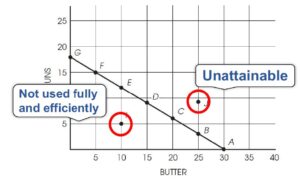Catalog
Chapter 1 Basic Economic Concepts
Chapter 2 Supply and Demand
Chapter 3 Production Function and Cost Curve
Chapter 4 Market Structure
Chapter 5 Factor Markets
Chapter 6 Market Failure and the Role of Government
Chapter 1 Basic Economic Concepts
Scarcity 稀缺性
Definition
• Economics is the study of how people, firms, and societies use their scarce resources to best satisfy their unlimited wants.
• 经济学是学习人们、企业、社会如何去使用他们的稀缺资源去满足他们的无穷欲望的。
Scarce resources 稀缺资源(Factors of production 生产要素)
Labor劳动力 Land 自然资源 Capital 资本 Entrepreneurship 企业家精神
Opportunity costs 机会成本
• Opportunity cost is what must be sacrificed to obtain something.
• 机会成本是当我们需要获得某些东西的时候必须放弃的。
• Opportunity cost is the value of the next best use.
• 机会成本是下一个最佳用途的价值。
Resource allocation and Economic systems 资源分配和经济制度
Market economy / Capitalism 市场经济 / 资本主义
• In a market economy, the allocation of resources is left to the market forces of demand and supply, operating through the price mechanism.
• 在市场经济中,资源分配是由需求和供应的力量的价格机制运作的。
Advantages 好处:
• Self Interest 自我利益 每个个体利益最大化
• Prices 价格 不需要政府干预资源分配
• Private Property 财产私有制 个人拥有经济资源而不是政府
• Freedom 自由 个体可以自由获取资源生产商品服务,并且可以自由选择销售哪些他们的资源
• Competition 竞争 卖者和买者可以自由的进出市场,这可以激励创新
Disadvantage 缺点:
• 一些商品会供不应求和供过于求
• 一些商品会过度提供和过度消费
• 一些商品不会被提供,因为无利可图
Command / Planned Economy 计划经济
Advantages 好处:
• 政府可以根据国家利益做决定
• 政府可以更加平等的分配资源
Disadvantage 缺点:
• 官僚主义 导致无效率
• 缺乏竞争和盈利的动机,这些产品的质量往往很差,消费者几乎没有选择
Mixed Economy 混合经济
• 世界上大部分国家都采用政府命令和资本主义相结合的方式来解决基本的经济问题
Production possibilities curve (PPC) 生产可能性曲线
Definiton of PPC
• A production possibility curve shows the maximum level of output that an economy can achieve when using its existing resources in full.
• 生产可能性曲线展示了当充分利用现存资源时的最大产量。
• PPC is a model used to show the trade-offs associated with allocating resources.
• PPC是一个展示权衡分配资源的模型
Efficiency vs Inefficiency 有效率的和无效率的

PPC vs Opportunity costs
数量 下
X商品的机会成本 = \dfrac{Y商品数量的变化}{X商品数量的变化}
时间 上
X商品的机会成本 = \dfrac{生产1单位X商品的时间}{生产1单位Y商品的时间}
PPC vs Economic growth PPC与经济增长
• Changes in the amount of resources 资源数量的变化
• Changes in technology and productivity 技术和生产力的变化
Law of increasing costs 成本递增法则
• The law of increasing costs states that as more of a product is produced, the opportunity cost increases.
成本增加定律表明,产品生产越多,机会成本越高。
因为一些资源可以更有效用于生产某样东西而不是另一样。
Comparative advantage 比较优势
Absolute advantage 绝对优势
• Absolute advantage describes a situation in which an individual, business, or country can produce more of a good or service than any other producer with the same quantity of resources.
• 绝对优势是一个个体、企业或者国家可以在同样的资源的情况下可以生产更多的商品或者服务。
Comparative advantage 比较优势
• A nation has a comparative advantage if the opportunity cost is lower for that nation than for others.
• 如果一个国家生产某样东西的机会成本比其他国家低,他就有比较优势。
• If each country specializes in producing the good in which it has comparative advantage and traded for the other good, then both nations will consume more of both goods.
• 如果每个国家都专门生产它有比较优势的商品,并与其他商品进行贸易,那么两国都将消费更多的这两种商品。
• The terms of trade is the ratio at which one good can be exchanged for another.
• 贸易条件是一种商品与另一种商品交换的比率。
• Terms of trade must fall between the opportunity costs of both countries.
• 贸易条件必须介于两国的机会成本之间。
如果低于两个国家的机会成本,两个国家都希望购买商品
如果大于两个国家的机会成本,两个国家都希望出售商品
处于之间,这样双方一方购买一方出售,即可完成贸易
• Production specialization according to comparative advantage, not absolute advantage, results in exchange opportunities that lead to consumption possibilities beyond the PPC.
• 根据比较优势而不是绝对优势的生产专业化,会产生交换机会,导致超出PPC的消费可能性。
Cost-benefit analysis 成本效益分析
Explicit costs 显性成本 需要企业支出货币的投入成本
Implicit costs 隐性成本 不需要企业支出货币的投入成本(机会成本)
Total costs 总成本 = Explicit costs + Implicit costs
Marginal analysis and consumer choice 边际分析和消费者选择
Marginal benefit (MB) vs Marginal cost (MC) 边际效益和边际成本
• Marginal cost is the additional cost from the consumption of the next unit of a good or service.
• 边际成本是消费额外一单位商品或服务的额外成本。
• Marginal benefit is the additional benefit from the consumption of the next unit of a good or service.
• 边际成本是消费额外一单位商品或服务的额外效益。
• If MB > MC, do it!
• If MB = MC, stop doing it!
• If MB < MC, never do it!
Total utility vs Marginal utility 总效用和边际效用
• Utility is the total satisfaction received from consuming a good or service.
• 效用是指从消费一种商品或服务中获得的全部满足感。
• Marginal utility (MU) is the additional utility received from buying one more good or service.
• 边际效用是购买额外商品或服务而获得的额外效用。
• Consumers experience diminishing marginal utility in the consumption of goods and services
• 边际效用递减
Utility maximization rule 效用最大化法则
\dfrac{X商品的边际效用}{X商品的价格} = \dfrac{Y商品的边际效用}{Y商品的价格}
价格不变
如果边际效用需要增加,就少买,如果需要减少,就多买。
当效用公式相等时,就达到了最佳组合











Comments | NOTHING